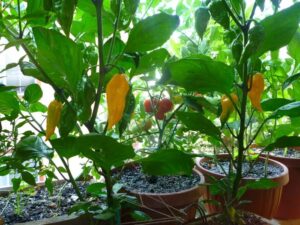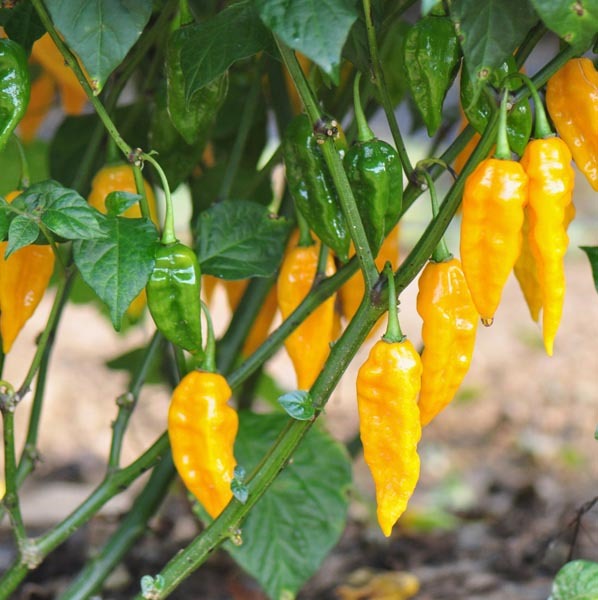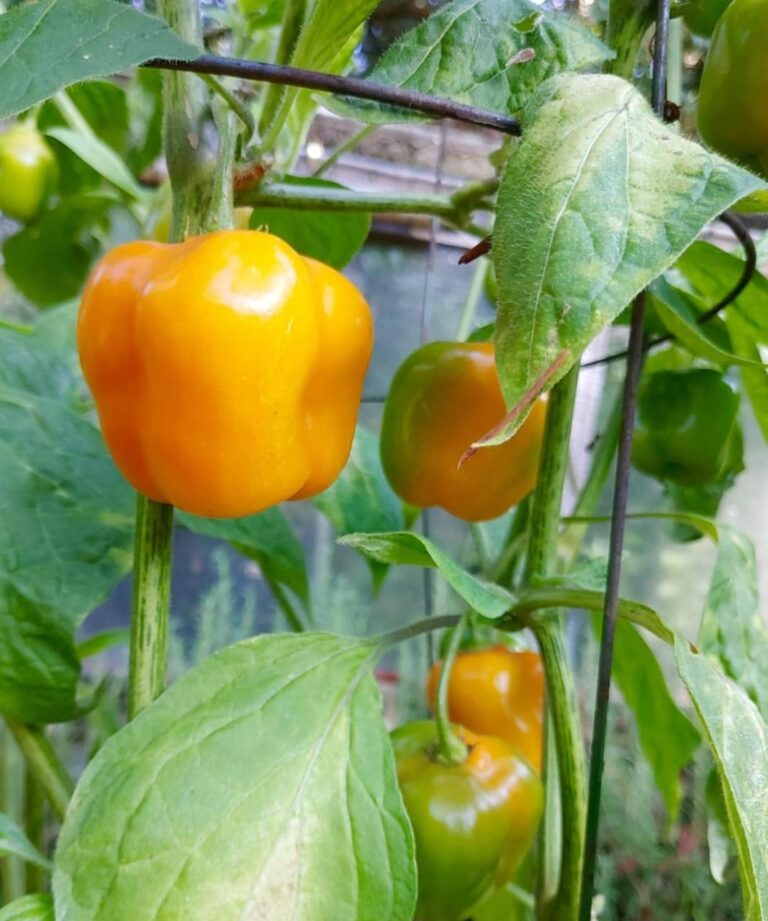Fatalii Pepper: 5 Exclusive Challenges and Considerations to Grow
Introduction
The Fatalii pepper, a Capsicum chinense variety, is a chili that captures the essence of heat and flavor in a way that few others do. This pepper, which originates in Central Africa, has gained popularity among chili enthusiasts due to its intense heat and unusual lemony flavor. In this blog, we’ll look at the Fatalii pepper’s origins, characteristics, production practices, culinary applications, health benefits, and scientific factors that make it a unique specimen in the world of hot foods.
Origin and History

The Fatalii pepper is thought to have originated in Central Africa, where it was grown by indigenous people. Although the exact historical pedigree is unknown, the pepper belongs to the Capsicum chinense species, including the Habanero and Scotch Bonnet peppers. Its African roots are obvious in its endurance and capacity to flourish in hot regions, making it a common ingredient in local diets and traditional cuisines.
The expansion of the Fatalii pepper beyond Africa demonstrates the global fascination with chili peppers. As trade channels extended, so did the reach of this spicy pepper, which eventually spread to other continents and is currently produced and enjoyed by chili fans all around the world. Today, the Fatalii is famous not just for its high heat, but also for its distinct flavor profile, which distinguishes it from other super-hot peppers.
Botanical Characteristics
Fatalii peppers are exceptionally gorgeous, having a brilliant yellow to orange hue when completely ripe. In some areas they grow chocolate fatalii too. The plants are relatively compact, reaching a height of 24-36 inches (60-90 cm), making them ideal for both garden beds and container gardening. The peppers are elongated and wrinkled, measuring about 2-3 inches (5-7 cm) in length. Their narrow walls make them suitable for drying and processing into chili powder.
One of the most remarkable features of this pepper is, its Scoville rating. The Fatalii ranks between 125,000 and 400,000 SHU on the Scoville heat unit scale, which quantifies the pungency of chili peppers. This makes it similar to, and sometimes hotter than, the Habanero. The Fatalii’s heat is recognized for its fast onset, packing a flaming punch nearly immediately after consumption, followed by a lingering burn.
Cultivation Practices of Fatalii Pepper
Growing Fatalii peppers may be a gratifying experience for gardeners, whether they are experienced chili growers or first-timers wishing to add heat to their gardens. These peppers grow in warm locations and require lots of sunlight, preferably 6-8 hours every day. They can be produced from seeds or seedlings, but seeds are often preferred because they are more widely available.
Seed Germination

Starting these peppers from seeds takes patience and attention to detail. The seeds should be placed in a well-drained potting mix that is kept warm (77-86°F or 25-30°C) and moist at all times. Germination time can range from 7 to 21 days, depending on the environment. A seedling heat mat can assist in maintaining the ideal temperature for rapid germination.
Transplanting and Growth
After the seedlings have developed a few sets of true leaves, they can be transplanted into larger pots or directly into the garden. If planting outdoors, it’s critical to wait until all danger of frost has passed and the soil temperature has warmed. Plants should be spaced about 18-24 inches (45-60 cm) apart to allow for proper air circulation and growth.

Soil and Watering Needs
Fatalii peppers appreciate well-drained loamy soil with a pH range of slightly acidic to neutral (6.0-6.8). They are drought-tolerant, but thrive with regular irrigation, particularly during the flowering and fruiting seasons. However, overwatering can cause root rot and other problems, so allow the soil to dry somewhat between watering sessions.
Fertilization
Fertilizing Fatalii peppers needs to be done carefully. During the growing season, apply a balanced fertilizer or one with a little higher phosphorus content to promote healthy development and prolific fruiting. However, too much nitrogen might result in lush foliage at the expense of fruit development, so it’s better to use a fertilizer schedule that promotes both flowering and fruiting.
Challenges and Considerations for a Gardener
1. Sensitivity to Temperature Fluctuations

Fatalii peppers, like many Capsicum chinense species, are extremely sensitive to temperature fluctuations. They flourish in consistently warm climes, with daytime temperatures ranging from 75-86°F (24-30°C). Sudden temperature reductions or cold exposure can impede plant development, impair fruit set, or even lead plants to stop producing entirely. For gardeners in lower locations, this sensitivity is a considerable challenge, needing regular weather monitoring and, in some cases, the use of greenhouses or indoor growth setups to maintain stable temperatures.
2. Pest and Disease Vulnerability
Despite its fiery nature, Fatalii peppers are susceptible to pests and illnesses. Aphids, whiteflies, and spider mites are frequent pests that can infest the plants, draining sap from the leaves and reducing the general health of the pepper. Furthermore, the plants are prone to fungal diseases such as powdery mildew and root rot, particularly in humid environments or when overwatered. Managing these dangers necessitates a proactive approach that includes regular inspection, the appropriate use of organic or chemical controls, and ensuring optimal air circulation around the plants to reduce the risk of illness.
3. Pollination Challenges
These peppers’ flowers need to be pollinated before they can bear fruit. While they self-pollinate, extrinsic conditions such as insufficient ventilation or a lack of pollinators can impede the process, resulting in poor fruit growth. Bees and other insects normally help with pollination in outdoor gardens, but this may not be as effective in indoor or greenhouse environments. To address this issue, gardeners may need to manually pollinate the blooms with a little brush to transfer pollen from one flower to another, which can be time-consuming and requires a delicate touch to prevent injuring the blossoms.
4. High Nutrient Demands

These demand more nutrition than other pepper cultivars. They require a well-balanced supply of nutrients throughout the growing season, especially during the flowering and fruiting periods. A lack of critical nutrients such as nitrogen, phosphate, and potassium (NPK) can lead to poor plant health, smaller fruit size, and poorer yields. However, over-fertilization, particularly with nitrogen, can cause excessive leaf growth at the price of fruit yield. To achieve the proper nutritional balance, soil fertility must be carefully monitored, fed on a regular basis with an appropriate fertilizer, and perhaps supplemented with micronutrients to ensure optimal plant development.
5. Harvesting and Handling Heat Intensity

Harvesting and handling this pepper might be difficult due of its strong heat. When harvesting these peppers, wear gloves to avoid skin irritation from capsaicin, the ingredient that causes the pepper’s spiciness. Even minimal contact with the skin or eyes might result in a burning sensation. Furthermore, processing the peppers, whether by cutting, drying, or frying, can release capsaicin into the air, irritating the eyes, nose, and throat. This demands adequate ventilation and safety equipment, particularly when dealing with big quantities of peppers. Managing these characteristics is critical for safely and effectively growing and using Fatalii peppers without discomfort or damage.
Culinary Uses
The Fatalii pepper is known for both its spiciness and its powerful lemony flavor, making it a versatile component in a range of cuisines. Its bright, fruity flavors complement both savory and sweet recipes, making it a favorite among chefs and home cooks alike. Watch y chili series where I discussed the usage of other chilies too.

1. Hot Sauces and Salsas
One of the most common use for Fatalii peppers is in hot sauces and salsa. Their brilliant color and distinct flavor make them an ideal foundation for sauces that are both visually appealing and tasty. The Fatalii’s heat complements tropical fruits such as mango, pineapple, and passion fruit, resulting in spicy and tangy sauces.
2. Spicy Condiments
Fatalii peppers can also be used to make hot sauces, infused oils, and spicy vinegars. These condiments can enhance the flavor of grilled meats and veggies, as well as sandwiches and salads. The thin walls of the peppers allow them to be dried and ground into a fine powder that can be used as a seasoning or spice blend.
3. Culinary Creativity
Fatalii peppers can be employed in a variety of imaginative culinary applications. They can be used for marinades, pickled for a sour flavor, or used to produce spicy treats such as chocolate truffles or pepper-infused syrups. The trick to cooking with Fatalii peppers is to temper the heat with complementary flavors, allowing the pepper’s distinctive lemony undertones to show through.
Health Benefits
Fatalii peppers, like other chili peppers, provide a variety of health benefits due to their high concentration of capsaicin, the substance responsible for their spiciness. Capsaicin has been extensively researched for its possible therapeutic benefits, which include pain reduction, metabolic boost, and cardiovascular health.
1. Pain Relief
Capsaicin is well-known for its pain-relieving properties, which involve desensitizing nerve receptors that carry pain signals to the brain. This characteristic has been employed in topical lotions and ointments to treat ailments such as arthritis, neuropathy, and muscle pain. While Fatalii peppers may not immediately cure pain, the presence of capsaicin contributes to their positive effect.
2. Metabolism and Weight Loss

Capsaicin has also been related to increased metabolic rate and fat oxidation, hence it is a common element in weight reduction pills. Consuming spicy foods, such as Fatalii peppers, activates the body’s thermogenic processes, causing a transient increase in calorie expenditure. Furthermore, the high heat may lower hunger, potentially aiding in weight loss.
3. Cardiovascular Health
The ingestion of chili peppers, particularly Fatalii, has been linked to enhanced cardiovascular health. Capsaicin is thought to help lower blood pressure, increase blood circulation, and reduce LDL cholesterol (the “bad” cholesterol). These effects help to minimize the risk of heart disease and strokes.
4. Rich in Vitamins and Antioxidants
Fatalii peppers are particularly high in vitamins A and C, which are essential for keeping a healthy immune system. Vitamin A is required for vision, skin health, and immunological function, whereas vitamin C is a potent antioxidant that protects the body against oxidative stress. Fatalii peppers contain antioxidants that can help reduce inflammation and protect against chronic diseases.
The Science Behind the Heat

These peppers generate a burning sensation because capsaicin binds to TRPV1 receptors in the tongue. These receptors are typically involved for perceiving heat, such as a hot beverage or a sunburn. When capsaicin attaches to these receptors, it sends a signal to the brain that causes the sense of physical heat, despite the fact that there is no actual temperature change.
Interestingly, capsaicin has a favorable effect on the human body. The first burn is frequently followed by the production of endorphins, the body’s natural painkillers, which can induce euphoria known as the “chili high”. This response is one of the reasons why people continue to seek out and like spicy meals, despite the high heat they cause.
Future Prospects
As demand for spicy meals grows, the Fatalii pepper is expected to remain a popular choice for both home gardeners and commercial farmers. Breeders may continue to create new types with higher heat levels, distinct flavors, or distinctive colors, enhancing the possibilities accessible to chili fans.
In the culinary world, the Fatalii’s adaptability ensures that it will be employed in new and imaginative ways. As more people discover this pepper’s distinct flavor, new meals and products may emerge that accentuate its lemony undertones and powerful heat.
Conclusion
This pepper is an intriguing and fierce chili that provides far more than just heat. From its roots in Central Africa to its use in modern cuisine, this pepper has had a great impact on the world of spicy dishes. Its distinct combination of extreme heat and citrusy flavor, as well as its possible health advantages, set it apart from the many varieties of chili peppers.
Whether you’re a gardener looking for a challenging and rewarding plant, a chef looking for bold flavors, or a chili fan looking to try the hottest peppers, the Fatalii has something for everyone. Its tale is one of perseverance, cultural significance, and the continued popularity of spicy dishes. As we continue to explore the universe of chili peppers, the Fatalii will surely remain a favorite among those who enjoy the rush of heat mixed with outstanding flavor.







